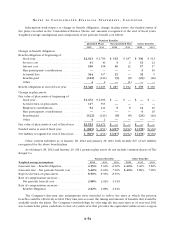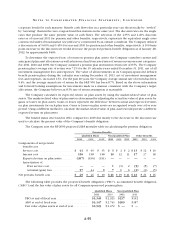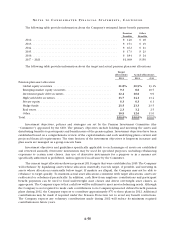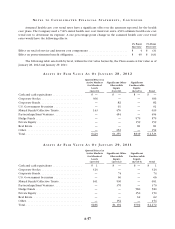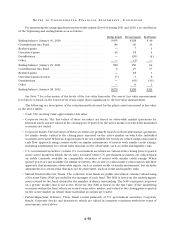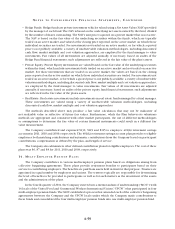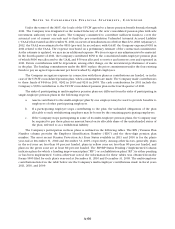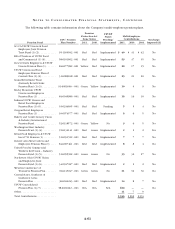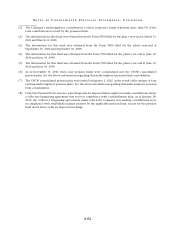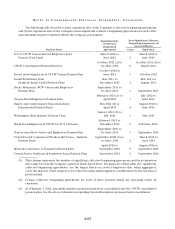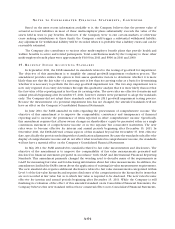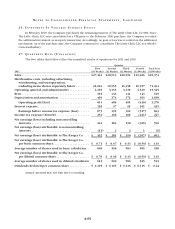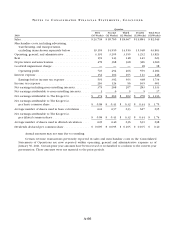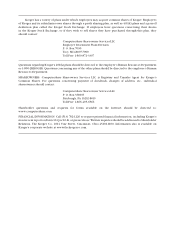Kroger 2011 Annual Report Download - page 119
Download and view the complete annual report
Please find page 119 of the 2011 Kroger annual report below. You can navigate through the pages in the report by either clicking on the pages listed below, or by using the keyword search tool below to find specific information within the annual report.A-64
NO T E S T O CO N S O L I D A T E D FI N A N C I A L ST A T E M E N T S , CO N T I N U E D
Based on the most recent information available to it, the Company believes that the present value of
actuarial accrued liabilities in most of these multi-employer plans substantially exceeds the value of the
assets held in trust to pay benefits. Moreover, if the Company were to exit certain markets or otherwise
cease making contributions to these funds, the Company could trigger a substantial withdrawal liability.
Any adjustment for withdrawal liability will be recorded when it is probable that a liability exists and can be
reasonably estimated.
The Company also contributes to various other multi-employer benefit plans that provide health and
welfare benefits to active and retired participants. Total contributions made by the Company to these other
multi-employer benefit plans were approximately $1,000 in 2011 and $900 in 2010 and 2009.
15. R E C E N T L Y IS S U E D AC C O U N T I N G ST A N D A R D S
In September 2011, the FASB amended its standards related to the testing of goodwill for impairment.
The objective of this amendment is to simplify the annual goodwill impairment evaluation process. The
amendment provides entities the option to first assess qualitative factors to determine whether it is more
likely than not that the fair value of a reporting unit is less than its carrying value as a basis for determining
whether it is necessary to perform the two-step goodwill impairment test. The two-step impairment test is
now only required if an entity determines through this qualitative analysis that it is more likely than not that
the fair value of the reporting unit is less than its carrying value. The new rules are effective for interim and
annual periods beginning after December 15, 2011; however entities were permitted to adopt the standards
early. The Company did not adopt these standards early for its 2011 goodwill impairment testing process.
Because the measurement of a potential impairment loss has not changed, the amended standards will not
have an effect on the Company’s Consolidated Financial Statements.
In June 2011, the FASB amended its rules regarding the presentation of comprehensive income. The
objective of this amendment is to improve the comparability, consistency and transparency of financial
reporting and to increase the prominence of items reported in other comprehensive income. Specifically,
this amendment requires that all non-owner changes in shareholders’ equity be presented either in a single
continuous statement of comprehensive income or in two separate but consecutive statements. The new
rules were to become effective for interim and annual periods beginning after December 15, 2011. In
December 2011, the FASB deferred certain aspects of this standard beyond the December 15, 2011 effective
date, specifically the provisions dealing with reclassification adjustments. Because the standards only affect the
display of comprehensive income and do not affect what is included in comprehensive income, the standards
will not have a material effect on the Company’s Consolidated Financial Statements.
In May 2011, the FASB amended its standards related to fair value measurements and disclosures. The
objective of the amendment is to improve the comparability of fair value measurements presented and
disclosed in financial statements prepared in accordance with GAAP and International Financial Reporting
Standards. This amendment primarily changed the wording used to describe many of the requirements in
GAAP for measuring fair value and for disclosing information about fair value measurements. In addition, the
amendment clarified the FASB’s intent about the application of existing fair value measurement requirements.
The new standard also requires additional disclosures related to fair value measurements categorized within
Level 3 of the fair value hierarchy and requires disclosure of the categorization in the hierarchy for items that
are not recorded at fair value but as to which fair value is required to be disclosed. The new rules became
effective for interim and annual periods beginning after December 15, 2011. While the Company is still
finalizing its evaluation of the effect of this amended standard on its Consolidated Financial Statements, the
Company believes this new standard will not have a material effect on its Consolidated Financial Statements.


